1997 CHEVROLET MALIBU high beam
[x] Cancel search: high beamPage 58 of 354
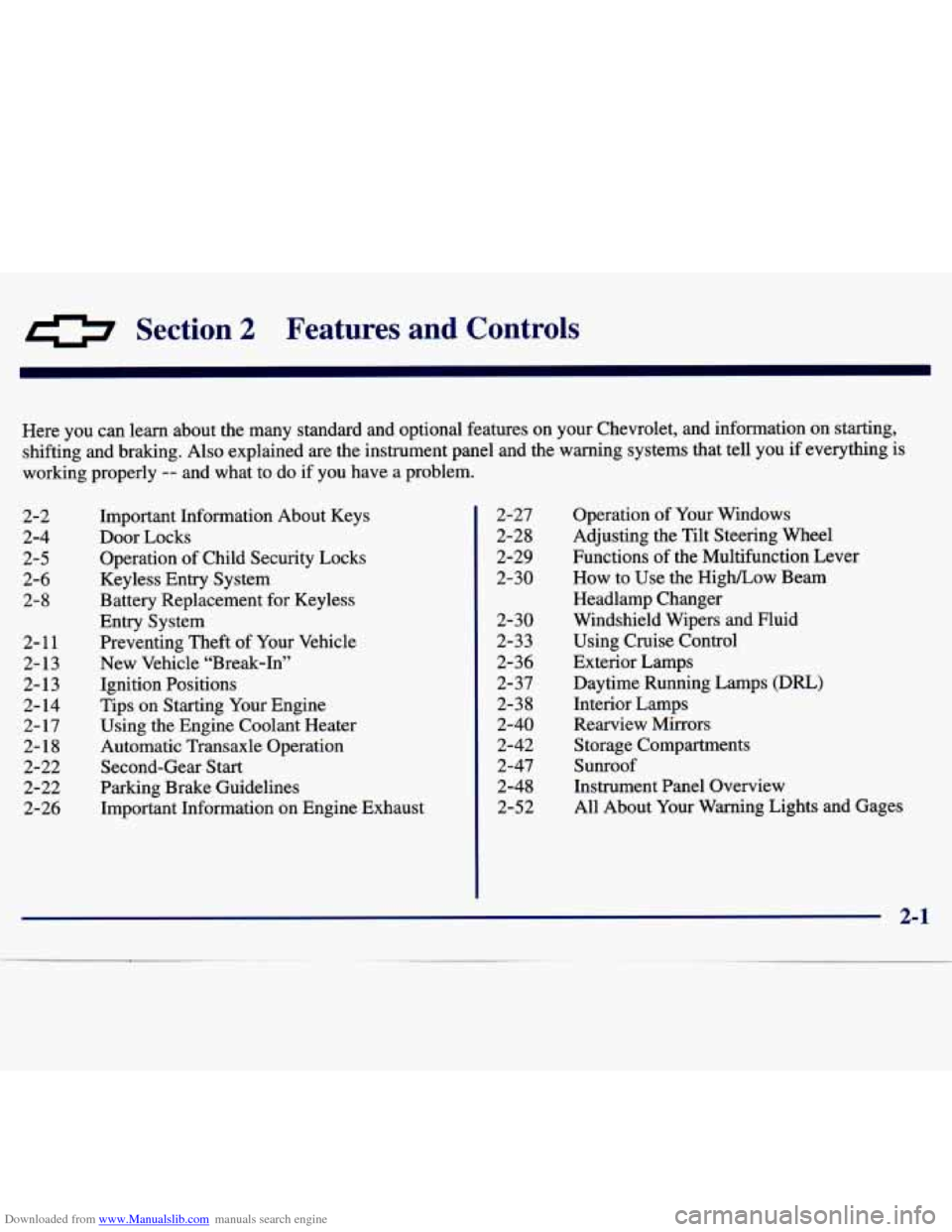
Downloaded from www.Manualslib.com manuals search engine Section 2 Features and Controls
2-2
2-4
2-5
2-6 2- 8
2-1
1
2-13 2-13
2- 14
2-
17
2-18
2-22
2-22
2-26
Here you can learn about the many standard and optional featur\
es on your Chevrolet, and information
on starting,
shifting and braking. Also explained are the instrument panel and the warning systems that tell you if everything is
working properly
-- and what to do if you have a problem.
Important Information About Keys
Door Locks Operation of Child Security Locks
Keyless Entry System
Battery Replacement for Keyless
Entry System
Preventing Theft
of Your Vehicle
New Vehicle “Break-In”
Ignition Positions
Tips on Starting Your Engine
Using the Engine Coolant Heater
Automatic Transaxle Operation
Second-Gear Start
Parking Brake Guidelines
Important Information on Engine Exhaust 2-27
2-28
2-29
2-30
2-30
2-33
2-36 2-37
2-3 8
2-40
2-42
2-47
2-48
2-52 Operation
of Your Windows
Adjusting the Tilt Steering Wheel
Functions of the Multifunction Lever
How to Use the High/Low Beam
Headlamp Changer
Windshield Wipers and Fluid
Using Cruise Control
Exterior Lamps Daytime Running Lamps (DRL)
Interior Lamps Rearview Mirrors
Storage Compartments
Sunroof
Instrument Panel Overview
All About Your Warning Lights and Gages
Page 87 of 354

Downloaded from www.Manualslib.com manuals search engine A warning chime signal will come on if you have left
your turn signal on
for more than 3/4 mile (1 km).
As you signal a turn or a lane change, if the arrows flash
rapidly, a signal bulb may be burned out and other drivers won’t see your turn signal.
If a bulb is burned out, replace it to help avoid an
accident. If the arrows don’t go on at all when you
signal a turn, check for burned-out bulbs and then check
the fuse (see “Fuses and Circuit Breakers” in the Index).
Headlamp High/Low Beam
To change the headlamps
from low beam to high
beam, push forward on the
turn signal/multifunction
lever.
To change the
headlamps from high beam
to low beam, pull the turn
signal lever backward.
When the high beams are
on, a light on the instrument
panel also will be on.
Flash to Pass
This feature lets you use your high-beam headlamps to
signal a driver in front of you that you want to pass.
To use it, pull the turn signal/multifunction lever toward
you until the high-beam headlamps come
on, then
release the lever to
turn them off.
Windshield Wipers
You control the windshield wipers by moving the stalk
with the wiper symbol on it up or down.
2-30
Page 95 of 354
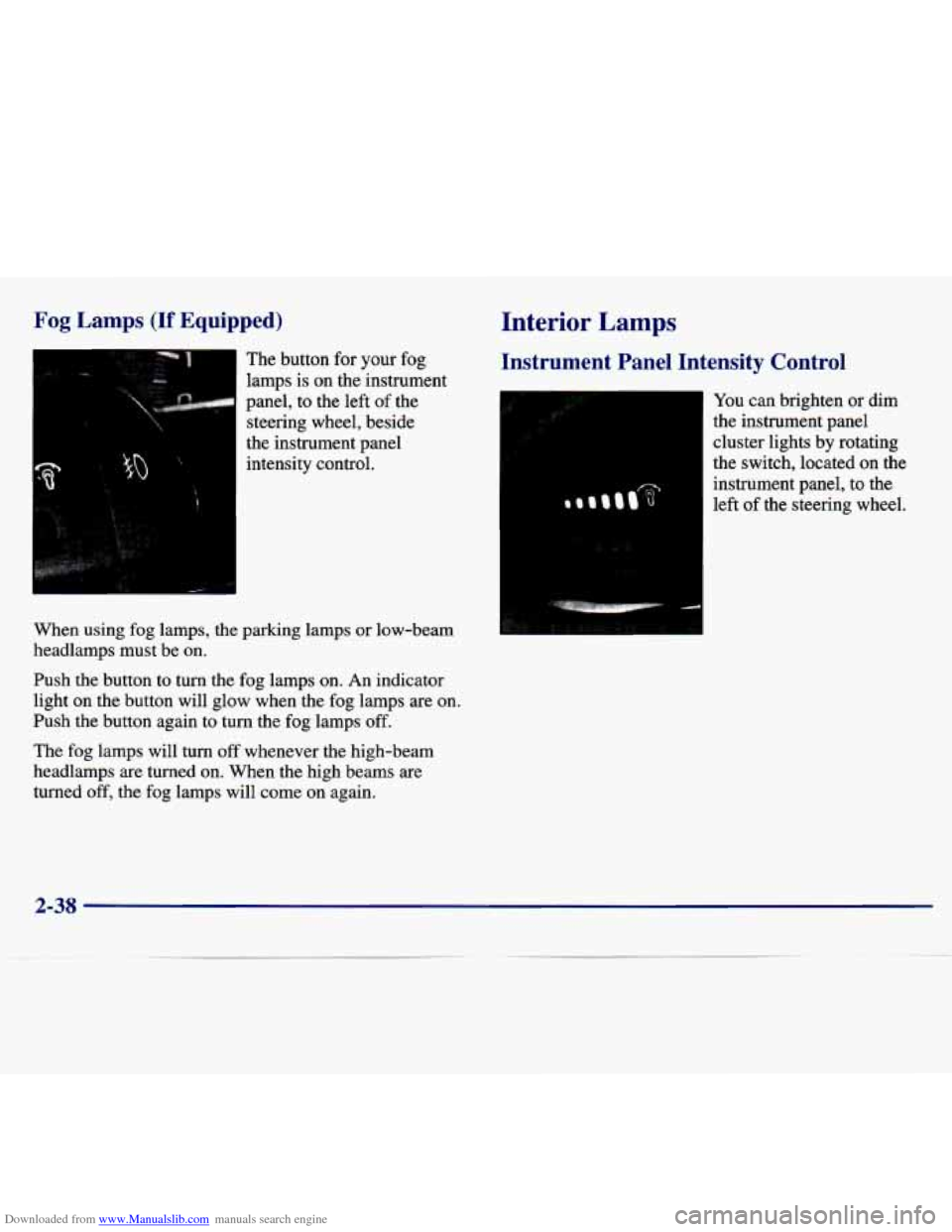
Downloaded from www.Manualslib.com manuals search engine Fog Lamps (If Equipped)
The button for your fog
lamps is on the instrument
panel, to the left of the
steering wheel, beside
the instrument panel intensity control.
When using fog lamps, the parking lamps or low-beam
headlamps must be on.
Push the button to turn the fog lamps on. An indicator
light
on the button will glow when the fog lamps are on.
Push the button again to turn the fog lamps off.
The fog lamps will turn off whenever the high-beam
headlamps are turned on. When the high beams are
turned off, the fog lamps will come on again.
Interior Lamps
Instrument Panel Intensity Control
You can brighten or dim
the instrument panel
cluster lights by rotating
the switch, located
on the
instrument panel, to the
left of the steering wheel.
2-38
Page 162 of 354

Downloaded from www.Manualslib.com manuals search engine Here are some tips on night driving.
0 Drive defensively.
0 Don’t dnnk and drive.
Adjust your inside rearview mirror to reduce the
Since you can’t see as well, you may need to slow
glare from
headlamps behind you.
down and keep more space between you and
other vehicles.
0 Slow down, especially on higher speed roads. Your
headlamps can light up only
so much road ahead.
In remote areas, watch for animals.
0 If you’re tired, pull off the road in a safe place
and rest.
Night Vision
No one can see as well at night as in the daytime. But as
we get older these differences increase. A 50-year-old
driver may require at least twice as much light to
see the
same thing at night as a 20-year-old.
What you do in the daytime can also affect your night
vision. For example, if you spend the day
in bright
sunshine you are wise to wear sunglasses. Your eyes will
have less trouble adjusting to night. But
if you’re
driving, don’t wear sunglasses at night. They may cut down on
glare from headlamps, but they also make a lot
of things invisible.
You can be temporarily blinded by approaching
headlamps. It can take a second or two, or even several
seconds, for your eyes to readjust to the dark. When you
are faced with severe glare (as from a driver who
doesn’t lower the high beams, or a vehicle with misaimed headlamps), slow down a little. Avoid staring
directly into the approaching headlamps.
Keep your windshield and all the glass on your vehicle
clean
-- inside and out. Glare at night is made much
worse by dirt on the glass. Even the inside of the glass
can build up a film caused by dust. Dirty glass makes
lights dazzle and flash more than clean glass would,
making the pupils of your eyes contract repeatedly.
Remember that your headlamps light up far less of a
roadway when you are in a turn or curve. Keep your
eyes moving; that way, it’s easier to pick out dimly lighted objects. Just as your headlamps should be
checked regularly for proper aim,
so should your eyes
be examined regularly. Some drivers suffer from night
blindness
-- the inability to see in dim light -- and
aren’t
even aware of it.
4-15
Page 165 of 354
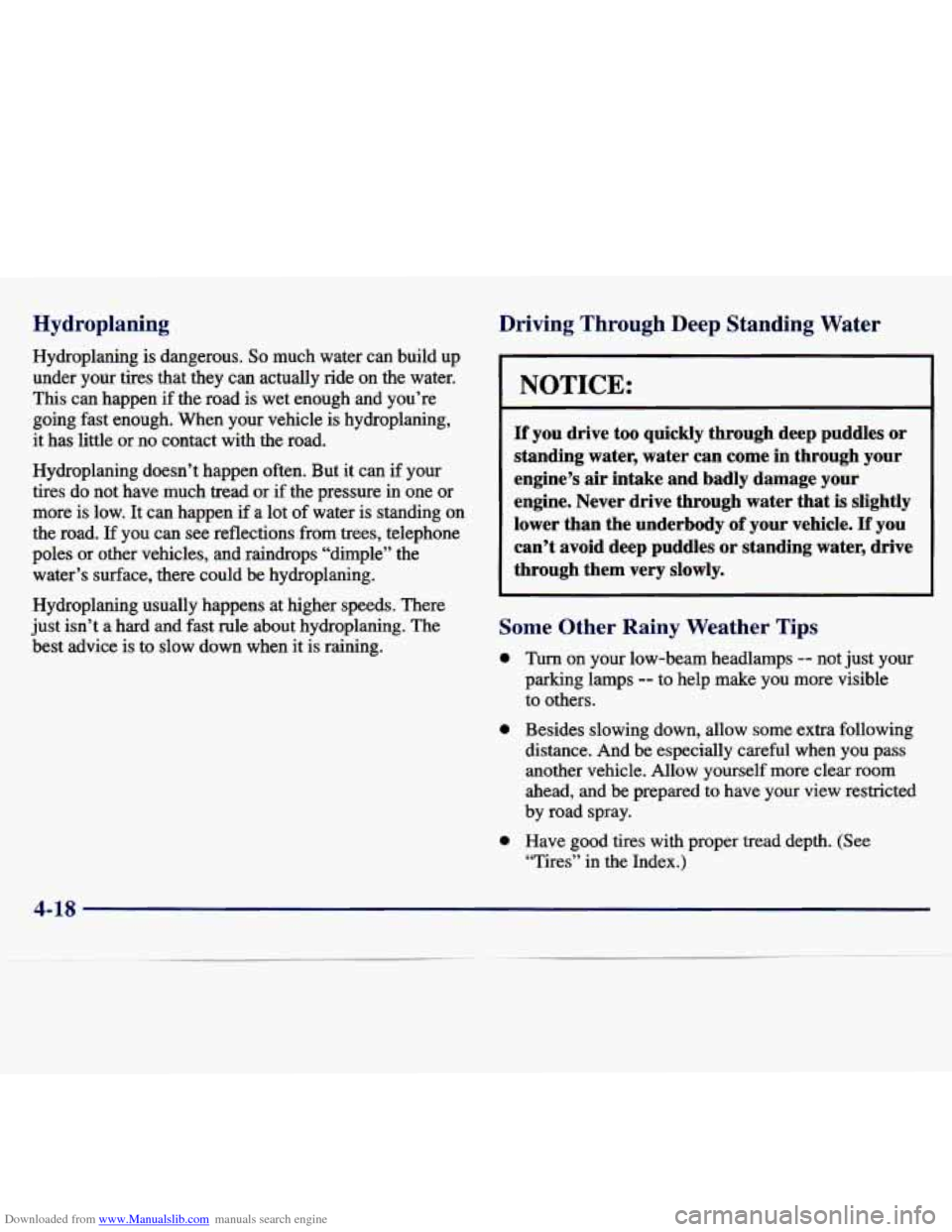
Downloaded from www.Manualslib.com manuals search engine Hydroplaning
Hydroplaning is dangerous. So much water can build up
under
your tires that they can actually ride on the water.
This can happen if the road is wet enough and you’re
going fast enough. When your vehicle is hydroplaning,
it has little or no contact with the road.
Hydroplaning doesn’t happen often. But it can if your
tires do not have much tread or if the pressure in one or
more is
low. It can happen if a lot of water is standing on
the road. If you can see reflections from trees, telephone
poles
or other vehicles, and raindrops “dimple” the
water’s surface, there could be hydroplaning.
Hydroplaning usually happens at higher speeds. There
just isn’t a hard
and fast rule about hydroplaning. The
best advice is to slow down when it
is raining.
1 Driving Through Deep Standing Water
NOTICE:
If you drive too quickly through deep puddles or
standing water, water can come in through your
engine’s air intake and badly damage your
engine. Never drive through water that is slightly
lower than the underbody
of your vehicle. If you
can’t avoid deep puddles or standing water, drive
through them very slowly.
Some Other Rainy Weather Tips
0 Turn on your low-beam headlamps -- not just your
parking lamps
-- to help make you more visible
to others.
0
0
Besides slowing down, allow some extra following distance. And be especially careful when you pass
another vehicle. Allow yourself more clear room
ahead, and be prepared to have your view restricted
by road spray.
Have good tires with proper tread depth. (See
“Tires” in the Index.)
4-18
Page 251 of 354

Downloaded from www.Manualslib.com manuals search engine Trent Exterior Bulbs Headlamp and Front
lbrn Signal Lamp
Bulb Replacement
When replacing a halogen bulb, do not touch the glass
portion of the bulb. The oil from your fingers will
shorten the life of your new halogen bulb. For the type
of bulb to use,
see “Replacement Bulbs” in the Index.
1. With the hood open and the engine off, pull the
fastener out of the plastic splash shield covering the
top of the headlamp assembly and remove it.
A. Front Turn Signal
B. High-Beam Headlamp
C. Low-Beam Headlamp
2. Carefully pull directly up on the two latches.
6-30
Page 252 of 354
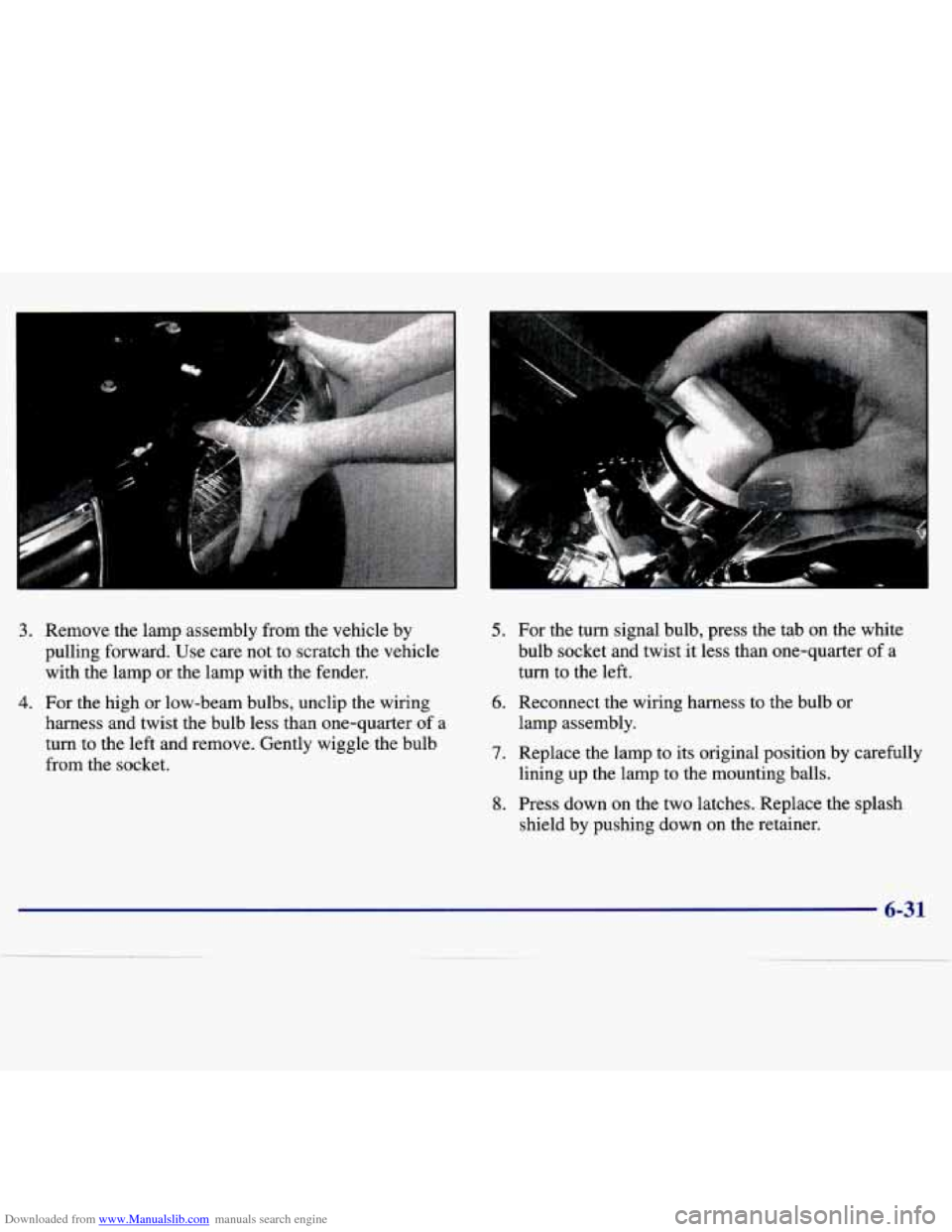
Downloaded from www.Manualslib.com manuals search engine 3. Remove the lamp assembly from the vehicle by
pulling forward. Use care not to scratch the vehicle
with the lamp or the lamp with the fender.
harness and twist the bulb less than one-quarter
of a
turn to the left and remove. Gently wiggle the bulb
from the socket.
4. For the high or low-beam bulbs, unclip the wiring
5. For the turn signal bulb, press the tab on the white
bulb socket and twist it less than one-quarter
of a
turn to the left.
6. Reconnect the wiring harness to the bulb or
lamp assembly.
lining up the lamp to the mounting balls.
7. Replace the lamp to its original position by carefully
8. Press down on the two latches. Replace the splash
shield by pushing down on the retainer.
6-31
Page 282 of 354
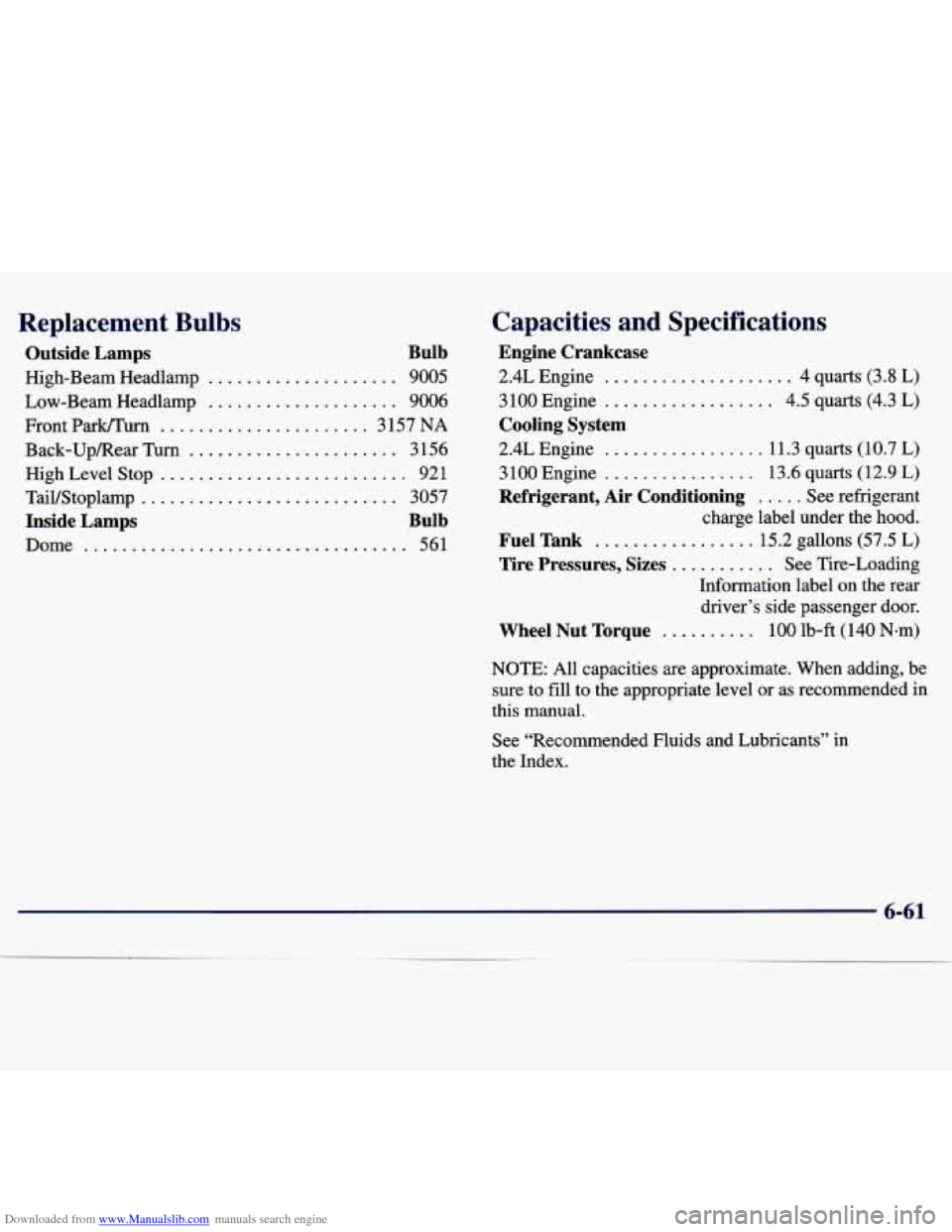
Downloaded from www.Manualslib.com manuals search engine Replacement Bulbs
Outside Lamps Bulb
High-Beam Headlamp .................... 9005
Low-Beam Headlamp
.................... 9006
Front Park/Turn
...................... 3 157 NA
Back-UpRear Turn ...................... 3 156
High Level Stop
.......................... 921
TaiVStoplamp
........................... 3057
Inside Lamps Bulb
Dome .................................. 561
Capacities and Specifications
Engine Crankcase
2.4L Engine .................... 4 quarts (3.8 L)
3 100 Engine .................. 4.5 quarts (4.3 L)
Cooling System
2.4L Engine ................. 11.3 quarts (10.7 L)
3100 Engine
................ 13.6 quarts (12.9 L)
Refrigerant, Air Conditioning ..... See refrigerant
charge label under the hood.
Fuel Tank ................. 15.2 gallons (57.5 L)
Tire Pressures, Sizes ........... See Tire-Loading
Information label
on the rear
driver’s side passenger door.
Wheel Nut Torque .......... 100 lb-ft (140 N-m)
NOTE: All capacities are approximate. When adding, be
sure to
fill to the appropriate level or as recommended in
this manual.
See “Recommended Fluids and Lubricants” in
the Index.
6-61